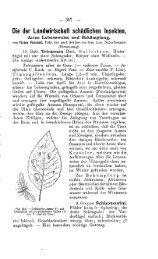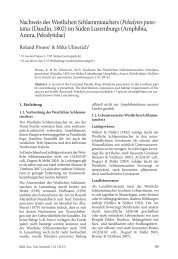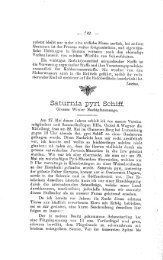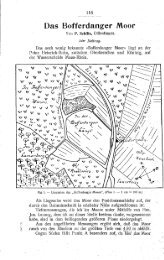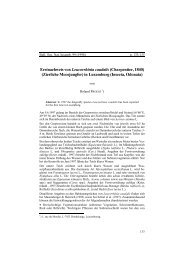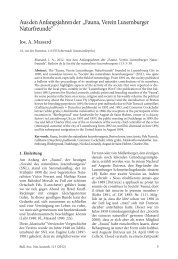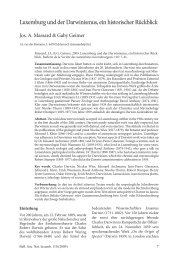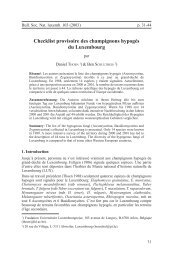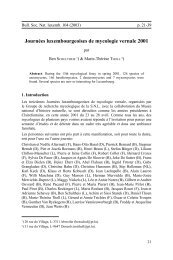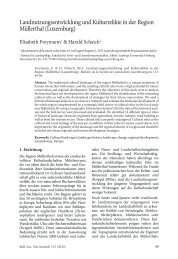Four new lichen-associated Trimmatostromaspecies ... - SNL
Four new lichen-associated Trimmatostromaspecies ... - SNL
Four new lichen-associated Trimmatostromaspecies ... - SNL
You also want an ePaper? Increase the reach of your titles
YUMPU automatically turns print PDFs into web optimized ePapers that Google loves.
2. Material and Methods<br />
The specimens examined are deposited in B,<br />
BR, HAL, NY, UCR and UPS, and in the private<br />
herbarium of P. Diederich. For microscopical<br />
examination, small fragments were<br />
examined in water, after light pressure on<br />
the cover glass, and in 5% KOH.<br />
3. Results<br />
Trimmatostroma dendrographae Diederich,<br />
Ertz, U. Braun & Heuchert sp. nov. Fig. 1<br />
MycoBank 518957.<br />
Trimmatostromatis quercicolae simile, sed catenis<br />
conidiorum macroscopice non distinctis,<br />
thallu hospitis plus minusve fuscescens, conidiis<br />
olivaceo-bruneis in aqua, intense olivaceis in<br />
KOH, 5.5–8.5 µm latis, pariete usque ad 1.2 µm<br />
crasso. Differt a Trimmatostromate salicis et T.<br />
betulino habitu <strong>lichen</strong>icola, stromatibus et sporodochiis<br />
nullis, coloniis dispersis supra thallos<br />
Dendrographae, conidiis olivaceo-brunneis, olivaceis<br />
in KOH, 0–pluriseptatis, 7–25 × 5.5–8.5<br />
µm, pariete rugoso-rimuloso.<br />
Type: U.S.A., California, Monterey Co., Carmel,<br />
Point Lobos State Reserve, 30 m alt., on Dendrographa<br />
sp., on Cupressus macrocarpa, 18 Jul.<br />
2008, P. Diederich 16789 & D. Ertz (BR – holotype;<br />
HAL, NY, UCR, herb. Diederich – isotypes).<br />
Colonies <strong>lichen</strong>icolous over the thallus of<br />
Dendrographa, usually covering the entire<br />
surface of the host thallus, blackish, macroscopically<br />
appearing as a finely granular<br />
mixture of blackish conidia and white<br />
host hyphae, the whole appearing pale to<br />
dark greyish at a low magnification (e.g.,<br />
in the field), individual chains of conidia<br />
hardly visible. Mycelium internal, hyphae<br />
sparingly branched, 2.5–3.5 µm wide, subhyaline<br />
to pale brown, septate, thin-walled,<br />
rugose. Stroma lacking. Conidiophores usually<br />
immersed, occasionally somewhat<br />
erumpent, micronematous, c. 20–70 × 2.5–4<br />
µm, hyphal filaments gradually developing<br />
into fertile threads by becoming somewhat<br />
wider and darker, with slightly thicker<br />
wall, but differentiation between hyphae<br />
and conidiophores very difficult, rugose.<br />
Conidiogenous cells integrated, terminal,<br />
monoblastic (i.e., the terminal cell functioning<br />
as conidiogenous cell), c. 5.5–9 × 3.5–4<br />
µm, conidiogenous loci undifferentiated,<br />
subtruncate. Conidia in simple or rarely<br />
branched, irregular, rarely disarticulating,<br />
basipetal chains, shape and size very variable,<br />
mostly ellipsoid-ovoid to subcylindrical<br />
or oblong, transversely 0–pluriseptate,<br />
rarely dictyosporous, ends more or less<br />
rounded, c. 7–25 × 5.5–8.5 µm, sometimes<br />
forming irregular aggregations, medium to<br />
dark brown or olivaceous-brown, distinctly<br />
olivaceous in KOH, wall 0.8–1.2 μm thick,<br />
wall rugose-rimulose.<br />
This species is distinguished from T. lecanoricola<br />
by olivaceous conidia in KOH, from<br />
T. hierrense by rugose-rimulose conidia and<br />
from T. quercicola by narrower conidia that<br />
are not visible macroscopically. Attempts to<br />
culture freshly collected material failed.<br />
Ecology, hosts and distribution: All known<br />
specimens are <strong>lichen</strong>icolous on epiphytic<br />
and saxicolous thalli of Dendrographa,<br />
including crustose, sorediate thalli that are<br />
considered to be the primary morph of the<br />
host, before the fruticose structures appear.<br />
In many specimens, fruticose thalli start<br />
growing, but are so heavily parasitized by<br />
this hyphomycete that they just reach up to<br />
1 cm in length and then die. This species is<br />
known only from the coast of California, and<br />
it appears to be rather common in localities<br />
where the host Dendrographa is present.<br />
Additional specimen examined (all on Dendrographa):<br />
USA, California, Monterey Co.:<br />
same locality as the type, on Cupressus macrocarpa,<br />
2008, Ertz 12482, 12487 & Diederich (BR);<br />
ibid., sheltered rock face near the sea, 2008, Ertz<br />
12441, 12453 & Diederich (BR); SW of Monterey,<br />
17 Mile Drive, Crocker Grove, alt. 15 m, on C.<br />
macrocarpa, 2008, Diederich 16767 & Ertz 12462<br />
(BR, herb. Diederich); along coast S of Asilomar,<br />
China Rock, alt. 5 m, on rock outcrop on the<br />
beach, 2008, Ertz 12480 & Diederich (BR).<br />
Trimmatostroma hierrense Diederich &<br />
Ertz sp. nov. Fig. 2<br />
MycoBank 518958.<br />
Differt ab omnibus speciebus Trimmatostromatis<br />
conidiis transverse septatis et parietibus conidiorum<br />
unilateraliter incrassatis et fuscatis.<br />
Type: Spain, Canary Islands, El Hierro, E of<br />
Frontera, trail between Frontera and ‘mirador de<br />
Jinama’ (part below ‘Fuente de Tincos’), 27°45’29”<br />
N, 17°59’29” W, ‘fayal brezal’ forest and rocky<br />
outcrops, on a root under a rock along trail, on cf.<br />
Bull. Soc. Nat. luxemb. 111 (2010) 49



